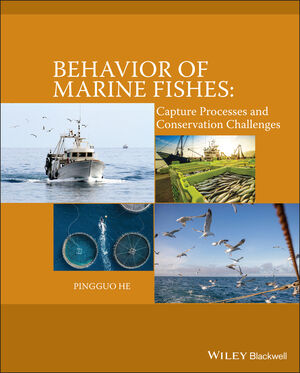Behavior of Marine Fishes: Capture Processes and Conservation ChallengesISBN: 978-0-8138-1536-7
Hardcover
400 pages
June 2010, Wiley-Blackwell
 |
||||||
Contributors ix
Preface xi
Clement S. Wardle
Introduction xiii
Pingguo He
Part One: Locomotion and Sensory Capabilities in Marine Fish 3
Chapter 1 Swimming in Marine Fish 5
John J. Videler and Pingguo He
1.1 Introduction 5
1.2 The Swimming Apparatus 5
1.3 Swimming-Related Adaptations 8
1.4 Styles of Swimming 12
1.5 Interactions between Fish and Water: Fish Wakes 13
1.6 Energy Required for Swimming 14
1.7 Swimming Speeds and Endurance 18
1.8 Concluding Remarks 19
Chapter 2 Fish Vision and Its Role in Fish Capture 25
Takafumi Arimoto, Christopher W. Glass, and Xiumei Zhang
2.1 Introduction 25
2.2 Structure of the Fish Eye 25
2.3 Visual Function 27
2.4 Visual Capacity: Visual Acuity, Separable Angle, and Maximum Sighting Distance 32
2.5 Color and Appearance of Fishing Gear Underwater 35
2.6 Fish Vision and Its Application in Fish Capture 36
2.7 Concluding Remarks 40
Chapter 3 Hearing in Marine Fish and Its Application in Fisheries 45
Hong Young Yan, Kazuhiko Anraku, and Ricardo P. Babaran
3.1 Introduction 45
3.2 Properties of Underwater Sound and Vibration 45
3.3 Underwater Sound Sources and Their Characteristics 47
3.4 General Morphology and Functions of Inner Ears and Ancillary Structures 48
3.5 Responses of Fish to Sound and Its Application in Fisheries 53
3.6 Concluding Remarks 60
Part Two: Fish Behavior near Fishing Gears during Capture Processes 65
Chapter 4 Fish Behavior near Bottom Trawls 67
Paul D. Winger, Steve Eayrs, and Christopher W. Glass
4.1 Introduction 67
4.2 Trawl Gear and Trawl Fisheries 67
4.3 Fish Behavior in the Pretrawl Zone (Zone 1) 69
4.4 Fi sh Behavior between Trawl Doors and in the Net Mouth (Zone 2) 75
4.5 Fish Behavior inside the Trawl Net and the Codend (Zone 3) 82
4.6 Factors Infl uencing Fish Behavior near Trawls 89
4.7 Concluding Remarks 95
Chapter 5 Fish Behavior in Relation to Longlines 105
Svein Løkkeborg, Anders Fernö, and Odd-Børre Humborstad
5.1 Introduction 105
5.2 Worldwide Longline Fisheries 106
5.3 Description of the Gear 108
5.4 Chemoreception and Food Search—The Basis for Bait Fishing 110
5.5 Interactions between the Fish and the Longline Gear 114
5.6 Conservation Challenges and Potential Solutions 123
5.7 Concluding Remarks 130
5.8 Future Challenges 132
Chapter 6 Fish Pots: Fish Behavior, Capture Processes, and Conservation Issues 143
Bjarti Thomsen, Odd-Børre Humborstad, and Dag M. Furevik
6.1 Introduction 143
6.2 Worldwide Use of Fish Pots 143
6.3 Fish Behavior in Relation to Pots 146
6.4 Conservation Challenges and Solutions 150
6.5 Concluding Remarks 154
Chapter 7 Large-scale Fish Traps: Gear Design, Fish Behavior, and Conservation Challenges 159
Pingguo He and Yoshihiro Inoue
7.1 Introduction 159
7.2 Trap Fisheries and Trap Designs 159
7.3 Fish Behavior in and around Traps 165
7.4 Fish Behavior and Trap Designs 170
7.5 Size and Species Selectivity and Mortality of Escapees and Discards 172
7.6 Conservation Issues and Mitigation Measures in Trap Fisheries 174
7.7 Concluding Remarks 178
Chapter 8 Fish Behavior near Gillnets: Capture Processes, and Influencing Factors 183
Pingguo He and Michael Pol
8.1 Introduction 183
8.2 Capture Mechanisms, Gear Designs, and Fishing Efficiency 184
8.3 Size Selectivity of Gillnets 187
8.4 Fish Behavior and Gillnet Fishing 189
8.5 Measures to Reduce Bycatch and Discards in Gillnets 192
8.6 Interaction of Marine Mammals, Seabirds, and Sea Turtles with Gillnets 195
8.7 Derelict Gillnets: Ghost Fishing Problems and Solutions 197
8.8 Concluding Remarks 198
Chapter 9 Electric Senses of Fish and Their Application in Marine Fisheries 205
Hans Polet
9.1 Introduction 205
9.2 Properties of an Electric Field in Water 206
9.3 The Electric Field 209
9.4 Application in Marine Fisheries 219
9.5 Conservation Issues 228
9.6 Concluding Remarks 231
Part Three: Contemporary Issues in Capture and Conservation in Marine Fisheries 237
Chapter 10 Technical Measures to Reduce Bycatch and Discards in Trawl Fisheries 239
Norman Graham
10.1 Introduction 239
10.2 Bycatch and Discard in World Fisheries 240
10.3 Cause of Bycatch and Discard 242
10.4 Technical Measures to Reduce Bycatch and Discard 242
10.5 Implementation of Discard Reduction Measures in Trawl Fisheries 257
10.6 Discussion 258
10.7 Concluding Remarks 259
Chapter 11 Mortality of Animals that Escape Fishing Gears or Are Discarded after Capture: Approaches to Reduce Mortality 265
Petri Suuronen and Daniel L. Erickson
11.1 Introduction 265
11.2 Mortality of Discards and Escapees 266
11.3 Assessment of Mortality 269
11.4 Factors Causing Stress, Injury, and Mortality 276
11.5 Measures to Improve Survival 283
11.6 Concluding Remarks 286
Chapter 12 Effect of Trawling on the Seabed and Mitigation Measures to Reduce Impact 295
Pingguo He and Paul D. Winger
12.1 Introduction 295
12.2 Review of Recent Studies on the Seabed Impact of Trawling 295
12.3 Description of Trawls and Their Operation 296
12.4 Pelagic and Semipelagic Trawls 299
12.5 Groundgear Modifi cations 301
12.6 Trawl Door Considerations 305
12.7 Other Trawl Gear Components 306
12.8 Beam Trawls 309
12.9 Concluding Remarks 310
Chapter 13 Measures to Reduce Interactions of Marine Megafauna with Fishing Operations 315
Dominic Rihan
13.1 Introduction 315
13.2 Species and Fisheries Involved 316
13.3 Extent of Bycatch 318
13.4 Nature of the Problem 320
13.5 Regulatory Frameworks 321
13.6 Potential Mitigation Measures 325
13.7 Concluding Remarks 337
Appendix
Species Names Mentioned in the Text 343
Index 347



